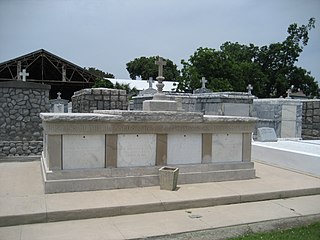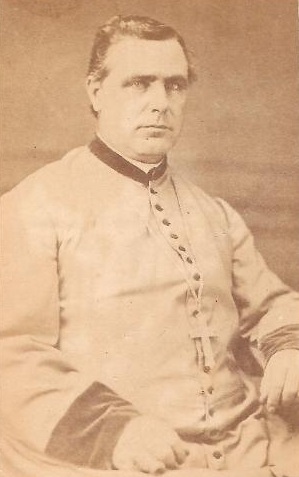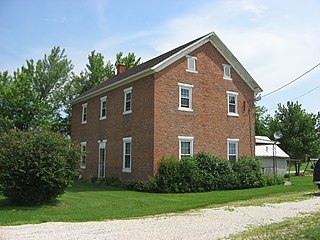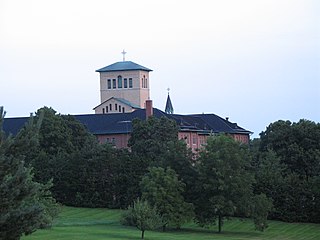The Franciscan Sisters of Christian Charity are a Congregation of Roman Catholic apostolic religious women. The congregation was founded in 1869 in Manitowoc, Wisconsin in the Roman Catholic Archdiocese of Milwaukee, later part of the Roman Catholic Diocese of Green Bay. The sisters have active apostolates in education, health care, spiritual direction, and other community ministries. As of 2021, there are 188 sisters in the community. The FSCC is a member of the Council of Major Superiors of Women Religious, an organization which represents women religious in the United States.

The Missionaries of the Precious Blood is a Catholic community of priests and brothers. The society was founded by Saint Gaspar del Bufalo in 1815.
The Sisters of St. Francis of Perpetual Adoration is a papal congregation of the Roman Catholic Church, founded on July 20, 1863, by Mother Maria Theresia Bonzel in Olpe, Germany. In 1875, they opened St. Elizabeth Hospital in Lafayette, Indiana; now part of the Franciscan Health healthcare system. In 1890 they founded Saint Francis Normal School, a teacher training school; which is now the University of Saint Francis (Indiana).

Maria Rickenbach Monastery is a Benedictine monastery of Religious Sisters. It is situated in the village of Niederrickenbach in the municipality of Oberdorf in the Swiss canton of Nidwalden. It is accessible to the public only by cable car from Niederrickenbach Station on the Luzern–Stans–Engelberg railway line, although there is a private road leading up to the village from Dallenwil.
The Third Order of Saint Francis is a third order in the Franciscan tradition of Christianity, founded by the medieval Italian Catholic friar Francis of Assisi.

The Holy Spirit Adoration Sisters are a Roman Catholic religious institute. The nuns live a contemplative life, focused on perpetual adoration of the Blessed Sacrament, offering intercessory prayers for the world 24 hours a day. Inside the enclosure the nuns wear rose-colored tunics with their habits symbolizing their joy for the Holy Spirit. As a consequence of these habits, the nuns are known colloquially as the "pink sisters".

The Sisters of the Blessed Sacrament (SBS) are a Catholic order of religious sisters in the United States. They were founded in 1891 by Katharine Drexel as the Sisters of the Blessed Sacrament for Indians and People of Color.

Maria Stein is a census-designated place in central Marion Township, Mercer County, Ohio, United States. The community and the Maria Stein Convent lie at the center of the area known as the Land of the Cross-Tipped Churches, where a missionary priest, Father Francis de Sales Brunner, established a number of parishes for German Catholics.

The Shrine of the Holy Relics in Maria Stein, Ohio is the second largest collection of relics in the United States. It is a part of the historic Maria Stein Convent.

Francis de Sales Brunner C.PP.S., in his native German Franz Sales Brunner, was a Roman Catholic missionary priest from Switzerland. Invited to the United States by Bishop John Baptist Purcell of Cincinnati, Brunner and his fellow Missionaries of the Precious Blood labored primarily among the German-speaking Catholics of Ohio. He founded several missions there. In 1850, Brunner built the Shrine of the Sorrowful Mother in Bellevue, Ohio, the oldest Marian shrine east of the Mississippi. It continues to be staffed by the Missionaries of the Precious Blood.
The Missionary Sisters of the Sacred Heart of Jesus is a Roman Catholic female religious congregation, founded in 1880 by Mother Frances Xavier Cabrini. Their aim is to spread devotion to the Sacred Heart by means of spiritual and corporal works of mercy. The sisters conduct homes for the aged and the sick, orphanages, industrial schools, sewing classes; they visit hospitals and prisons, and give religious instruction in their convents, which are open to women desirous of making retreats. The congregation operates in 15 countries on 6 continents, coordinated by its motherhouse in Rome.

The Sisters of the Humility of Mary is a Roman Catholic religious congregation, founded at Dommartin-sous-Amance, France, in 1855. The community immigrated to the United States in 1864, and established themselves near New Bedford, Pennsylvania. This community is known as the Sisters of the Humility of Mary and is based at Villa Maria, Pennsylvania.

The Sisters of St. Mary of Oregon, formerly known as the Sisters of the Most Precious Blood, is a Catholic religious congregation founded in 1886 in the U.S. state of Oregon. The sisters' convent is located in Beaverton and they are independent from the Archdiocese of Portland.

Joseph Gregory Dwenger, C.P.P.S was an American prelate of the Catholic Church. He served as Bishop of Fort Wayne from 1872 to 1893.

St. John the Baptist Catholic Church is a historic Roman Catholic church in Marion Township, Mercer County, Ohio, United States. Located in the unincorporated community of Maria Stein, it is the home of an active congregation and has been recognized as a historic site because of its well-preserved late nineteenth-century Romanesque Revival architecture.

The Gruenwald Convent is a historic former Roman Catholic convent in the far western part of the U.S. state of Ohio. Located approximately 0.5 miles (0.80 km) south of the small community of Cassella in Mercer County, the convent was built in 1854. It is one of six convents that were built by the Missionaries of the Precious Blood in this portion of Ohio and in adjacent portions of far eastern Indiana, and one of only two that remain without significant alterations.
The Sisters of Notre Dame of Coesfeld is a Catholic religious institute. Members use the postnominal letters SND. The congregation was founded in Coesfeld, Germany, during a time of religious and social need. In 1849, Hilligonde Wolbring and Elisabeth Kuhling took in orphaned and neglected children, and educated and cared for them. Wolbring and Kuling established the Sisters of Notre Dame of Coesfeld to continue their work. During Kulturkampf, the sisters were forced to leave Coesfeld, and traveled to the U.S. where they taught in parishes in Ohio and Kentucky and, eventually, in many other locations. Sr. Mary Ann Culpert, SND is the current superior general of the congregation.
The Sisters of the Precious Blood is a Roman Catholic female religious order founded in 1845 in Steinerberg, Switzerland by Magdalene Weber and a number of young women from Baden.















